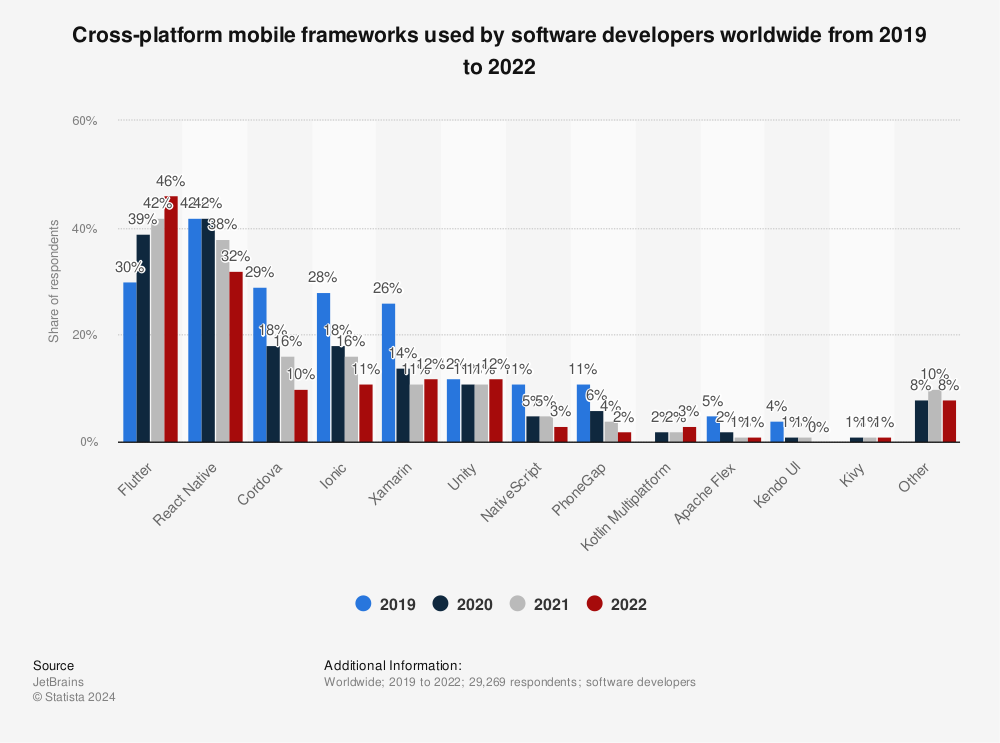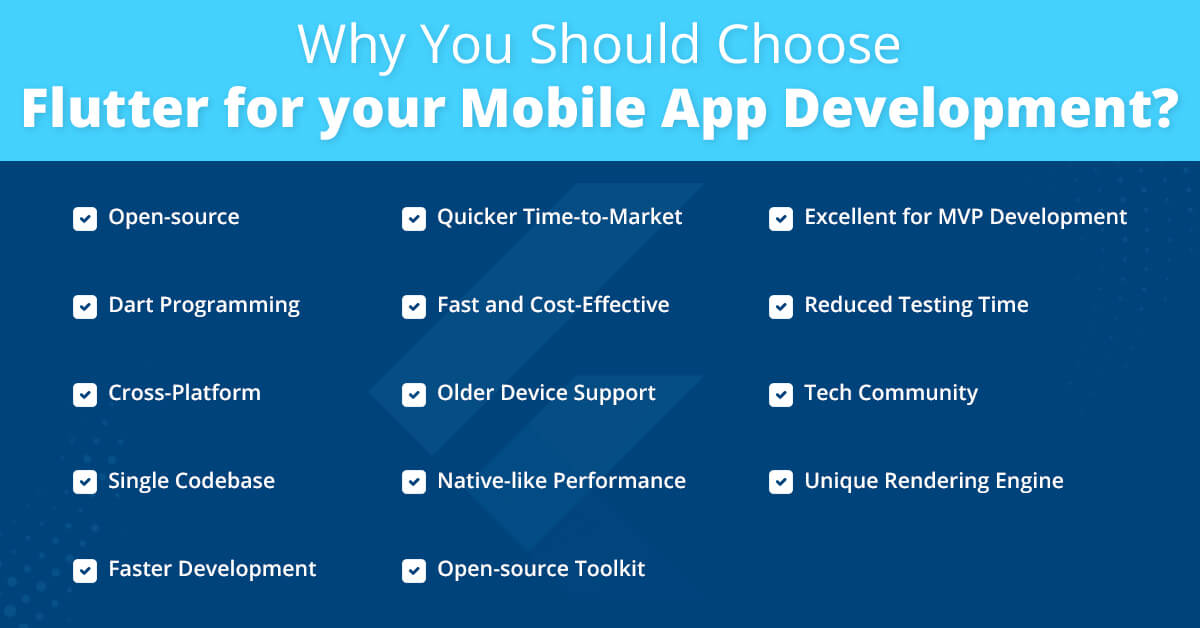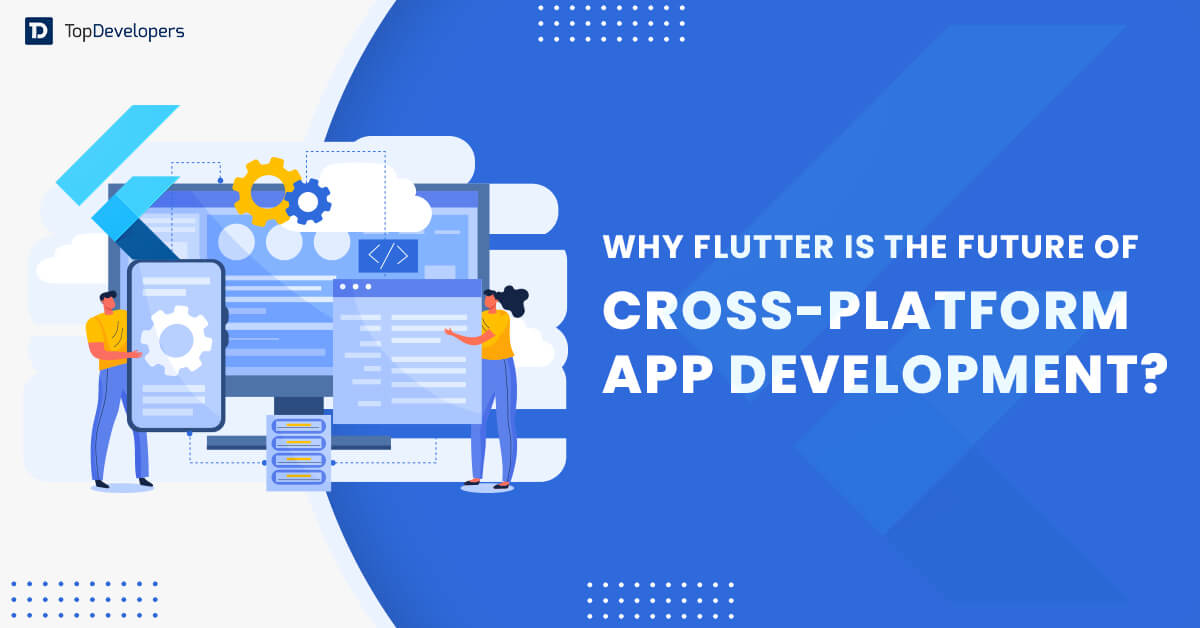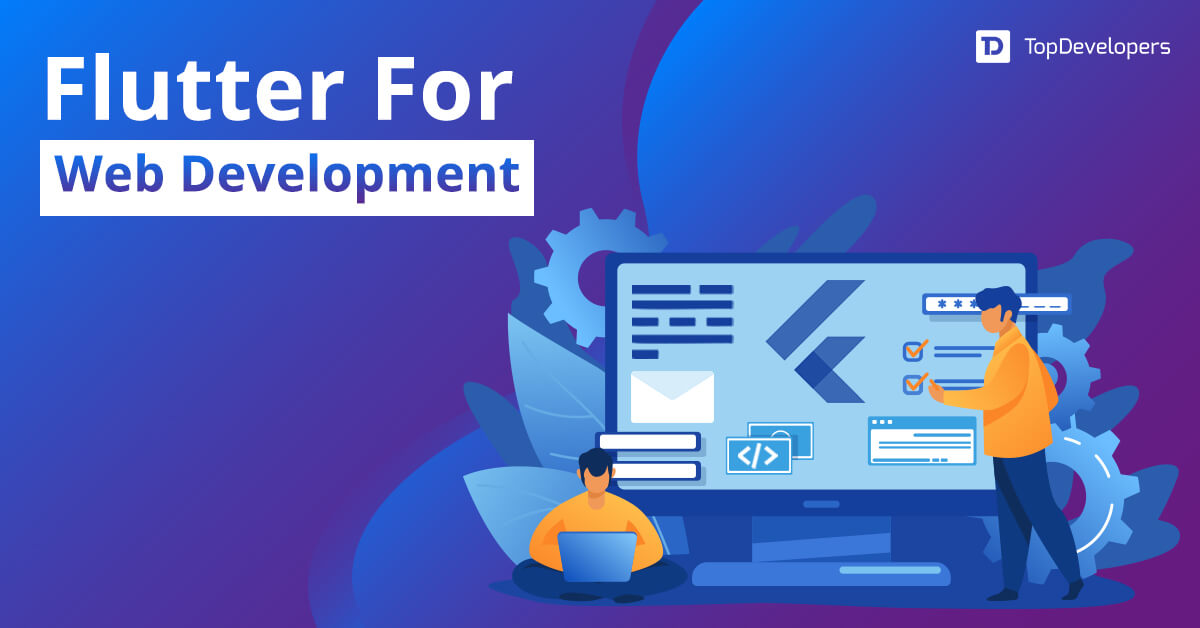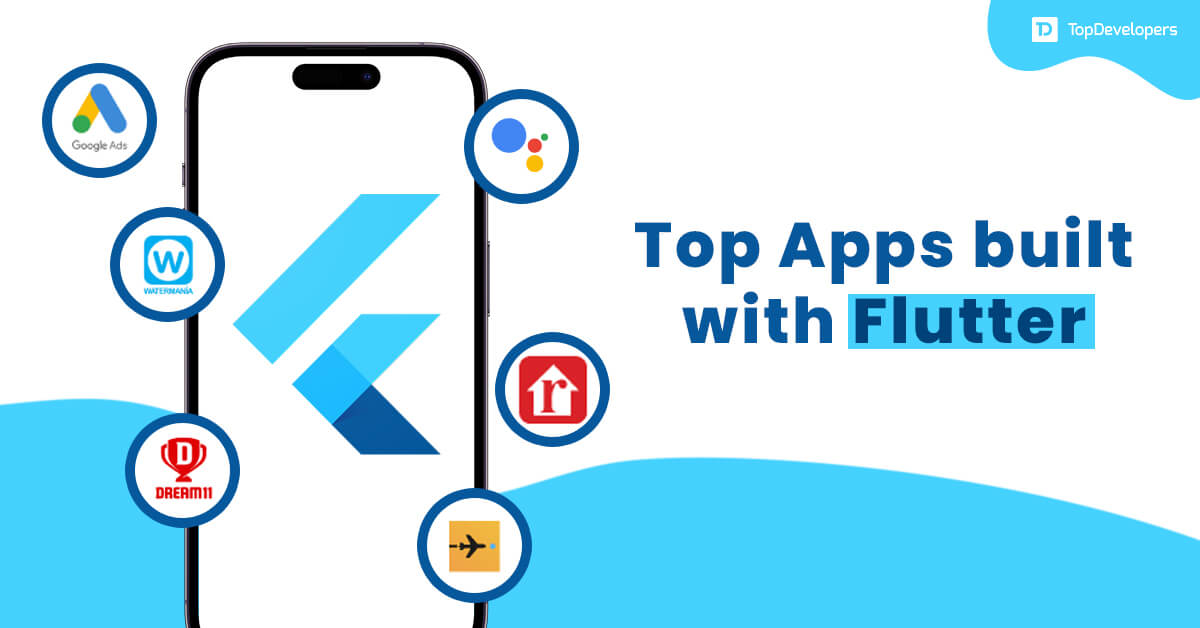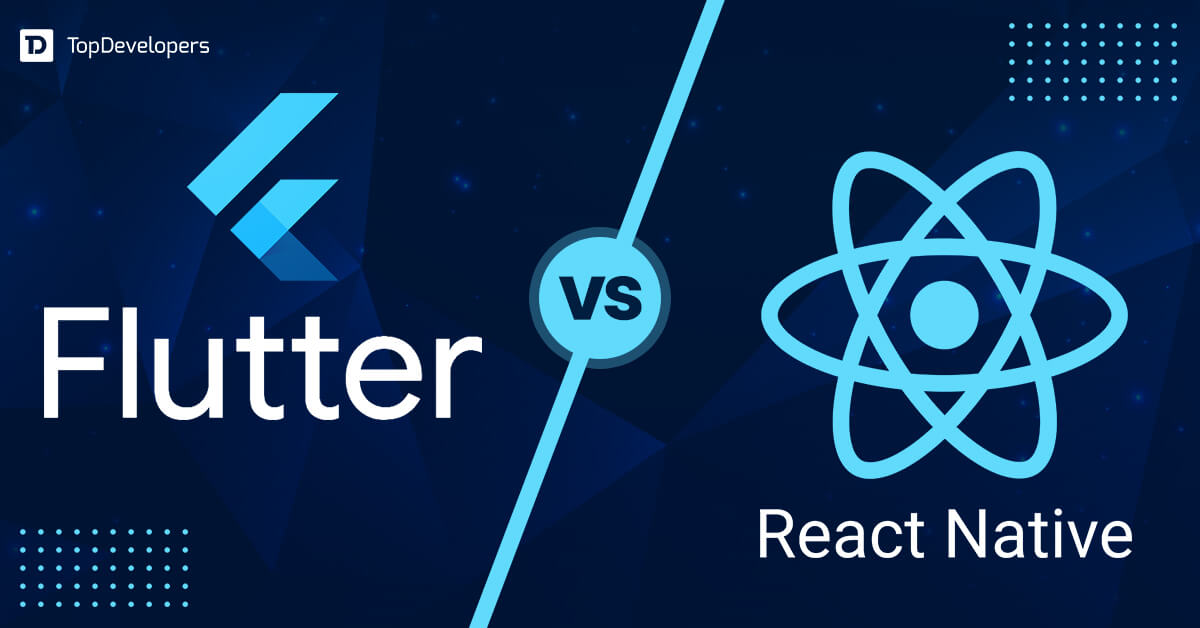
Quick Summary: Are you looking to build a mobile app, but unsure which technology to choose to ensure its success in the competitive digital market? Look no further than Flutter! It’s the best option you have currently got. But, before you rush to hire Flutter developers to develop your mobile application, you may want to explore why choose this technology. Hence, we have made it simpler for you by writing this guide. Explore why you should choose Flutter for mobile app development in 2023 and ahead.—
Every business is in a mad rush to create robust mobile apps. As of now, there are over 8.93 million apps on all play stores and app stores combined. As the number of mobile apps is rising day in, and day out, the selection of the right mobile app development framework is one of the growing challenges among businesses. Even though the selections for app development framework should purely be on the requirement of the project, Flutter maintains to be at the top in every situation, for every mobile app development project.
Find more statistics at Statista
Google created a revolutionary, open-source mobile app development platform that allows you to develop apps for iOS and Android platforms without hiring separate developers. Hire Flutter developers and they build cross-platform applications using a single codebase.
If a business wants to develop a simple, affordable, and scalable mobile app offering faster development and release time to market, Flutter is perfect for it. This blog will shed more light on why Flutter is the ideal choice for businesses and how it can help companies achieve their objectives.
Without further ado, let’s get straight into it.
Table of Contents
What is Flutter?
In simple language, Flutter is an open-source UI software development kit. This kit enables Flutter developers to build powerful, feature-rich, cross-platform applications with a single code base.
Since the release of its first stable version on December 4, 2018, Flutter has made huge performance improvements. It consists of three architectural layers, namely framework, engine, and embedder. Flutter 3.10, the latest version of Flutter framework, can be used for desktop and web app development. Also, it can help to build apps for any screen with its responsive feature.
Key Features of Flutter
Built on Dart Programming Language: The Flutter framework, written in Dart programming language, is the layer that developers interact with and use to write Flutter applications. Additionally, the framework layer consists of three layers that help to render widgets such as material and Cupertino and help to adapt the style of your Flutter app according to the platform.
C++: The engine layer is written in C++, designed to handle input, output, and network requests while managing tough rendering challenges whenever a frame requires painting.
Compatible with Multiple Operating Systems: The embedded layer enables the Flutter app to run on any operating system. Whether it’s Android, iOS, Linux, MacOS or Windows, Flutter is compatible with all of them.
High Performance: Out of all the frameworks, Flutter is the only framework with a mobile SDK that provides a responsive style minus the JavaScript bridge. Hence, Flutter’s performance is superior to frameworks such as React Native.
Hot Reload: Time is everything for modern businesses and they want things faster and more conveniently. With Hot Reloading feature of Flutter, the development time is significantly reduced. It helps Flutter developers instantly view the changes made to the code without restarting the application. It saves lot of developer time as they don’t have to wait to see changes that they made.
Customizable Widgets: Flutter is best known for creating excellent user interfaces and with a rich set of customizable widgets, it affirms its commitment. These widgets follow the Material Design guidelines for Android and Cupertino style for iOS.
Top Reasons Why Use Flutter for Mobile App Development?
Indeed, Flutter’s SDK is not the top choice for developers but also the best framework for building highly secure and beautiful applications for multiple platforms. It ranks among the top 10 software repo on GitHub with over 109k stars, making it one of the most popular technologies.
So, What makes Flutter so popular among developers? Let’s look at a few points as to why Flutter is the best choice for mobile app development by developers.
Did you know 100 of Fortune 500 companies, such as Toyota, BMW, eBay, Grab, etc. are built on Flutter?
Open-source Toolkit
Since Flutter is Google’s portable UI toolkit, developers can obtain solutions to issues and access documentation on forums. Developers will stay informed about the latest Flutter updates and changes, updating their knowledge while contributing to the platform.
With all the support, knowledge, and guidance, Flutter developers can code faster and more efficiently, resulting in timely project completion.
Open-source
In the past few years, open source has become a movement and a way of working that goes beyond software production. Flutter and Dart both provide extensive documentation and community support to assist you with any issues you may run into. The best part about both of them is that they are free to use and open source. As Flutter also works on existing code, it can be easily used by organizations and developers around the globe. This enables designers to deliver their full creative vision and potential without being forced to water it down due to the limitations of the underlying framework.
Dart Programming
Dart is an object-oriented programming language developed by Google. Initially released in 2011, it has been continuously evolving since its launch. Keeping in mind four dimensions for evaluation, Flutter has developed Dart considering the needs of users, developers and framework authors. The Dart compilers and runtimes support the combination of two primary features i.e. a JIT-based fast development cycle and an Ahead Time compiler. Both of these play a huge role in state hot reloads, shape-changing, the performance of production deployments and ARM code for fast startup.
Flutter works closely with the Dart community by actively investing resources in improving Dart for use in Flutter. The Dart community and contributors are trying to make it better by introducing new updates and significant changes.
Cross-Platform
Developing apps for iOS, Android, and other platforms can be challenging for novice developers. With the same code base for all platforms, Flutter app developers can write codes for various platforms simultaneously. Which ultimately helps businesses to save on budget as well if they are looking to have apps for multiple platforms.
Single Codebase
The days of writing separate codes for Android and iOS are history. Flutter follows a write-once approach. With Flutters’ code reusability, you have to write just one codebase and use it not only for mobile, iOS but also for desktop, web and more. The one codebase for all platforms cuts development time, filters cost significantly and allow you to launch your app much faster. When using Flutter, the best part is that the code becomes multi-platform and only needs to update once.
Flutter being a hybrid application development framework reduces the daily efforts of both developers and users. The developers can quickly improve the designs, speed, and quality of the application because a single codebase is required on multiple platforms. It surpassed the traditional way of writing separate code for separate operating systems.
Faster Development
Being a cross-platform framework having a single codebase, Flutter saves a lot of developers’ precious time. It lets them focus more on the core functionality of the app and saves a lot of time working on the UI. In Flutter, you can see your UI changes in the device or simulator in just 1 second through one click or save the file option. The stateful hot reload helps in bringing cross-platform applications to life.
Flutter framework contains functions and fields allowing developers to quickly view the effects of their changes. For businesses looking for democratizing and neutralizing their product on multiple platforms, Flutter significantly reduces time to develop.
Quicker Time-to-Market
The Flutter app development process usually takes 2–6 months. Depending on the complexity of the project, the development time may vary. For example, a basic project may take 2 months, a moderately challenging Flutter app may take 4 months and lastly, a complex Flutter app can take 6 months to build.
The secret lies in Flutter’s valuable features like a single code base, and easily available and reusable widgets, and components. The best part is the hot reload feature that eliminates the need to restart the application after a code tweak.
Fast and Cost-Effective
Companies need mobile apps quickly and time is not a luxury for developers. Flutter reflects real-time changes, facilitating experimentation, building UIs, the addition of new features, and bug-fixing.
Once a Flutter developer exercises the hot-reload option, the host machine compares the edited code against the last compilation while compiling the following libraries;
- Any library with changed code
- Application’s main library
- Libraries in the primary library connected to affected libraries
Next, the updated source code files enter the Dart Virtual Machine that updates classes with new fields and functions, allowing the Flutter framework to spontaneously rebuild, repaint and re-lay the widget tree. In this way, skilled developers can see the effects of the implemented changes, resulting in increased productivity and faster app development.
Older Device Support
Be it Windows, iOS or Android, all operating systems are rolling out updates on a regular basis that may be excruciating for developers. However, the Flutter app will remain unchanged on the system, irrespective of the platform’s version.
This amazing feature saves valuable time and resources while ensuring an optimal user experience.
Native-like Performance
Flutter uses the Dart programming language that compiles it into native code for multiple platforms using the Flutter SDK, resulting in superior, native-like performance. Let’s take this comparison – Flutter vs React Native. Flutter has a slight edge over React Native, surpassing it by 4%.
Unsurprisingly, Flutter has 487,428 results compared to React Native’s library with 355,832 results (as of Feb 2023).
Excellent for MVP Development
Due to its innumerable advantages, Flutter is perfect for MVP (Minimum Viable Product) development. Since Flutter apps are compatible with many platforms and deliver an optimized user experience, many investors will be willing to pour in their finances.
Compared to native apps, companies can put their business model and idea to the test much faster in the real market and reap rich dividends. Last but not least, mobile app development using Flutter offers immense scalability.
Flutter’s four-layer architectural pattern [Presentation Layer, Controllers Layer, Service Layer, Model Layer] gives you the tools to build scalable, flexible and maintainable apps. Developers can separate the app into different layers to organize the code, improve testability, and increase scalability. As your Flutter app becomes more complex, your developers can add new functionality by incorporating new layers into the architecture.
Reduced Testing Time
Unlike other frameworks, Flutter mobile app development does not require extensive testing to be done manually as it offers automated testing so you can have production-quality apps in no time. Run the app once and you are good to go, saving developers precious time and resources.
Tech Community
As Flutter is the brainchild of Google, it bestows high reliability and is backed by massive community support. Being an open-source framework, Flutter has attracted a huge and active community of developers since its initial release. This community is hyperactive and constantly publishes code examples and supports developers in creating beautiful and innovative cross-platform applications. Flutter has Discord, Reddit, Medium, YouTube and also its own website to build up its community.
The documentation on these repositories is a huge help in the Flutter development community. It helps connect developers and links resources that can answer questions on troubleshooting issues and allow developers to share feedback.
Unique Rendering Engine
Some cross-platform solutions are quite similar on Android and iOS. Hence, Flutter is a great choice for developers because it has separate packages with a unique collection of widgets for both platforms.
Top Mobile Apps Built With Flutter
Built and released by Google, Flutter is the most trusted framework among the world’s top brands worldwide. From eBay and Alibaba to Toyota and Tencent, brands from Fortune 500 adopted this technology to build high-performing applications. We have listed out some of the top businesses from the list of many.
Let’s explore;
- eBay Motors
- Google Ads
- Google Pay
- The New York Times
- MyBMW
- NuBank
- Realtor.com
- Alibaba Group
- Toyota
- Tencent
When to Use Flutter?
Flutter app development is ideal when clients want quick results. When companies want reasonably complex apps but at the same time they don’t want to compromise on quality or usability, Flutter is the best choice. In a nutshell, Flutter is best in the below scenarios.
- Small/Medium complexity projects
- When clients want apps ready within a short time
- If clients want native-like applications
When Should You Not Use Flutter?
Flutter is extremely versatile with its cross-platform development framework, hot reload features, highly customizable UI design, a wide choice of widgets and other factors. However, Flutter is not ideal under the following circumstances.
- If the project requires a Wear OS version or Smart TV app because WearOS does not support many of Flutter’s development features. With Android app development using Flutter, you will have to start from zero with the control logic.
- When the app has to be of a certain size.
- Not suitable for apps connected to a hardware device over Bluetooth because it may lead to performance and connectivity issues.
- If the apps require third-party plugins, check if the latest version SDK is available on Flutter. Flutter lacks many popular libraries and SDK.
- Flutter for the web does not deliver performance. However, it may roll out updates to address this problem in the future.
Final Thoughts
This article is all about helping businesses and entrepreneurs explore the potential of Flutter for mobile app development. We have explored and explained why Flutter is the right choice for building your mobile application. We have also explored when to use Flutter for app development and when you should avoid using it. If you want to create effective applications for multi-platforms, Flutter is the one for you. However, before you approach a Flutter app development company, you can explore the top-rated Flutter engineers here at TopDevelopers.
 Avantika Shergil
| Jun 6, 2023
Avantika Shergil
| Jun 6, 2023
Avantika Shergil is a technology enthusiast and thought leader with deep expertise in software development and web technologies. With over 8 years of experience analyzing and evaluating cutting-edge digital solutions, Avantika has a knack for demystifying complex tech trends. Her insights into modern programming frameworks, system architecture, and web innovation have empowered businesses to make informed decisions in the ever-evolving tech landscape. Avantika is passionate about bridging the gap between technology and business strategy, helping businesses build customized software and website, and understand about different tools to leverage effectively for their ventures. Explore her work for a unique perspective on the future of digital innovation.
